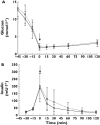Glucagon is absorbed from the rectum but does not hasten recovery from hypoglycaemia in patients with type 1 diabetes
- PMID: 18507661
- PMCID: PMC2485256
- DOI: 10.1111/j.1365-2125.2008.03173.x
Glucagon is absorbed from the rectum but does not hasten recovery from hypoglycaemia in patients with type 1 diabetes
Abstract
Aims: A failure to secrete glucagon during hypoglycaemia is near universal in patients with type 1 diabetes 5 years after disease onset and may contribute to delayed counter-regulation during hypoglycaemia. Rectal glucagon delivery may assist glucose recovery following insulin-induced hypoglycaemia in such patients and has not been previously studied.
Methods: Six male patients (age 21-38 years) with type 1 diabetes (median duration 10 years) without microvascular complications, were studied supine after an overnight fast on two separate occasions at least 14 days apart. After omission of their usual morning insulin and 45 min rest, hypoglycaemia was induced by an intravenous insulin infusion which was terminated when capillary glucose concentration reached 2.5 mmol l(-1). Subjects were randomized to insert a rectal suppository containing 100 mg indomethacin alone (placebo) or 100 mg indomethacin plus 1 mg glucagon at the hypoglycaemic reaction. Serial measurements were made for 120 min.
Results: In the two groups, mean (SD) plasma glucose concentrations fell to a similar nadir of 1.8 (0.7) mmol l(-1) (placebo) and 2.1 (1.2) mmol l(-1) (glucagon). Peak plasma glucagon following hypoglycaemia was higher in the glucagon group; 176 (32) ng l(-1)vs. 99 (22) ng l(-1) after placebo (P = 0.006). However, the glucose recovery rate over 120 min after hypoglycaemia did not differ significantly.
Conclusions: Our results provide evidence for the absorption of glucagon from the rectum. They also indicate that 1 mg does not constitute a useful mode of therapy to hasten recovery from hypoglycaemia in patients with type 1 diabetes.
Figures



References
-
- Cryer PE. Hypoglycemia: the limiting factor in the glycaemic management of type 1 and type 2 diabetes. Diabetologia. 2002;45:937–48. - PubMed
-
- Muhlhauser I, Berger M, Sonnenberg G, Koch J, Jorgens V, Schernthaner G, Scholz V, Padagogin D. Incidence and management of severe hypoglycaemia in 434 adults with insulin-dependent diabetes mellitus. Diabetes Care. 1985;8:268–73. - PubMed
-
- Freychet L, Rizkalla SW, Desplanque N, Basdevant A, Zirinis P, Tchobroutsky G, Slama G. Effect of intranasal glucagon on blood glucose levels in healthy subjects and hypoglycaemic patients with insulin-dependent diabetes. Lancet. 1988;331:1364–6. - PubMed
-
- Braatvedt GD, Newrick PG, Halliwell M, Wells PNT, Read AE, Corrall RJM. Splanchnic haemodynamic changes during acute hypoglycaemia in man. Clin Sci. 1991;81:519–24. - PubMed
Publication types
MeSH terms
Substances
LinkOut - more resources
Full Text Sources
Other Literature Sources
Medical

